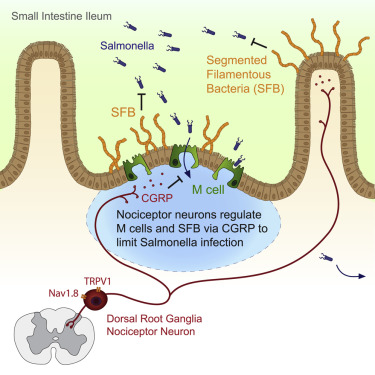Our official English website, www.x-mol.net, welcomes your
feedback! (Note: you will need to create a separate account there.)
Gut-Innervating Nociceptor Neurons Regulate Peyer's Patch Microfold Cells and SFB Levels to Mediate Salmonella Host Defense.
Cell ( IF 45.5 ) Pub Date : 2019-12-05 , DOI: 10.1016/j.cell.2019.11.014 Nicole Y Lai 1 , Melissa A Musser 2 , Felipe A Pinho-Ribeiro 1 , Pankaj Baral 1 , Amanda Jacobson 1 , Pingchuan Ma 1 , David E Potts 1 , Zuojia Chen 3 , Donggi Paik 1 , Salima Soualhi 4 , Yiqing Yan 1 , Aditya Misra 1 , Kaitlin Goldstein 1 , Valentina N Lagomarsino 1 , Anja Nordstrom 5 , Kisha N Sivanathan 6 , Antonia Wallrapp 6 , Vijay K Kuchroo 6 , Roni Nowarski 6 , Michael N Starnbach 7 , Hailian Shi 8 , Neeraj K Surana 9 , Dingding An 4 , Chuan Wu 3 , Jun R Huh 1 , Meenakshi Rao 4 , Isaac M Chiu 1
Cell ( IF 45.5 ) Pub Date : 2019-12-05 , DOI: 10.1016/j.cell.2019.11.014 Nicole Y Lai 1 , Melissa A Musser 2 , Felipe A Pinho-Ribeiro 1 , Pankaj Baral 1 , Amanda Jacobson 1 , Pingchuan Ma 1 , David E Potts 1 , Zuojia Chen 3 , Donggi Paik 1 , Salima Soualhi 4 , Yiqing Yan 1 , Aditya Misra 1 , Kaitlin Goldstein 1 , Valentina N Lagomarsino 1 , Anja Nordstrom 5 , Kisha N Sivanathan 6 , Antonia Wallrapp 6 , Vijay K Kuchroo 6 , Roni Nowarski 6 , Michael N Starnbach 7 , Hailian Shi 8 , Neeraj K Surana 9 , Dingding An 4 , Chuan Wu 3 , Jun R Huh 1 , Meenakshi Rao 4 , Isaac M Chiu 1
Affiliation

|
Gut-innervating nociceptor sensory neurons respond to noxious stimuli by initiating protective responses including pain and inflammation; however, their role in enteric infections is unclear. Here, we find that nociceptor neurons critically mediate host defense against the bacterial pathogen Salmonella enterica serovar Typhimurium (STm). Dorsal root ganglia nociceptors protect against STm colonization, invasion, and dissemination from the gut. Nociceptors regulate the density of microfold (M) cells in ileum Peyer's patch (PP) follicle-associated epithelia (FAE) to limit entry points for STm invasion. Downstream of M cells, nociceptors maintain levels of segmentous filamentous bacteria (SFB), a gut microbe residing on ileum villi and PP FAE that mediates resistance to STm infection. TRPV1+ nociceptors directly respond to STm by releasing calcitonin gene-related peptide (CGRP), a neuropeptide that modulates M cells and SFB levels to protect against Salmonella infection. These findings reveal a major role for nociceptor neurons in sensing and defending against enteric pathogens.
中文翻译:

肠道神经伤害感受器神经元调节派尔氏集结微褶皱细胞和 SFB 水平以介导沙门氏菌宿主防御。
肠道支配的伤害性感觉神经元通过启动包括疼痛和炎症在内的保护性反应来响应伤害性刺激;然而,它们在肠道感染中的作用尚不清楚。在这里,我们发现伤害感受器神经元关键介导宿主针对细菌病原体肠沙门氏菌鼠伤寒血清型(STm)的防御。背根神经节伤害感受器可防止 STm 定植、入侵和从肠道传播。伤害感受器调节回肠派尔氏集结 (PP) 滤泡相关上皮 (FAE) 中微褶皱 (M) 细胞的密度,以限制 STm 入侵的进入点。 M 细胞的下游,伤害感受器维持节段丝状细菌 (SFB) 的水平,SFB 是一种存在于回肠绒毛上的肠道微生物,PP FAE 介导对 STm 感染的抵抗力。 TRPV1+ 伤害感受器通过释放降钙素基因相关肽 (CGRP) 直接响应 STm,CGRP 是一种调节 M 细胞和 SFB 水平以防止沙门氏菌感染的神经肽。这些发现揭示了伤害感受器神经元在感知和防御肠道病原体方面的主要作用。
更新日期:2019-12-05
中文翻译:

肠道神经伤害感受器神经元调节派尔氏集结微褶皱细胞和 SFB 水平以介导沙门氏菌宿主防御。
肠道支配的伤害性感觉神经元通过启动包括疼痛和炎症在内的保护性反应来响应伤害性刺激;然而,它们在肠道感染中的作用尚不清楚。在这里,我们发现伤害感受器神经元关键介导宿主针对细菌病原体肠沙门氏菌鼠伤寒血清型(STm)的防御。背根神经节伤害感受器可防止 STm 定植、入侵和从肠道传播。伤害感受器调节回肠派尔氏集结 (PP) 滤泡相关上皮 (FAE) 中微褶皱 (M) 细胞的密度,以限制 STm 入侵的进入点。 M 细胞的下游,伤害感受器维持节段丝状细菌 (SFB) 的水平,SFB 是一种存在于回肠绒毛上的肠道微生物,PP FAE 介导对 STm 感染的抵抗力。 TRPV1+ 伤害感受器通过释放降钙素基因相关肽 (CGRP) 直接响应 STm,CGRP 是一种调节 M 细胞和 SFB 水平以防止沙门氏菌感染的神经肽。这些发现揭示了伤害感受器神经元在感知和防御肠道病原体方面的主要作用。









































 京公网安备 11010802027423号
京公网安备 11010802027423号